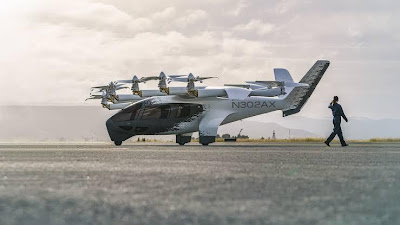The urban transport sector is dynamic and innovative, with air taxis emerging as a potential gamechanger. Often likened to futuristic vehicles, air taxis have the potential to revolutionize urban mobility by addressing issues like congestion and travel time, offering a fresh perspective on the future of urban transportation.
Air Taxis, what are they?
Wikipedia defines air taxis as “an application of advanced air mobility—air transportation systems that
utilize advanced technologies such as vertical takeoffs, autonomous capabilities, or fully electric
systems for short to midrange on-demand flights.
To put it simply, air taxis are an efficient air travel option, bridging the gap between private jets and
airplanes.
 |
| cntraveller.in |
Advantages of Air Taxis:
Air taxis are the future of aviation; they provide a way to beat the urban transportation challenges by soaring above the ground and its traffic.
It has the potential to reduce traffic congestion on the ground, especially in heavily populated urban areas.
By avoiding traffic, travel time reduces as well. People could travel to school or work faster.
It would also be beneficial in emergency situations where, with air taxis, the ambulances wouldn’t get stuck in traffic.
Electrically powered air taxis have the potential to reduce greenhouse gas emissions and air pollution.
They could also help travel to remote areas where the way to roads may be difficult.
The development of air taxis is a further advancement in aviation technology, including autonomous flight systems and electric propulsion,
paving the way for more sustainable and efficient aircraft.
 |
| Joby |
Challenges faced:
Despite their potential, air taxis face several challenges before they can become a mainstream mode of transportation. Some of these hurdles are discussed below :
● Regulatory Hurdles: The existing airspace regulations do not suffice, which in turn, will not be
able to work the special needs of unmanned aerial vehicles (UAVs). Besides, the solutions
required to ensure the safe and orderly operation of air taxis in crowded skies will be gravely by
the framework.
● Infrastructure Development: Air taxi operations will only be successful if infrastructure like
vertiports (landing zones) and charging stations are built, a task which necessarily means
commensurate investment and cooperation among the private and public sectors.
● Public Acceptance: Among the, the public willingness to trust is credible. In order to enable the
spread of mass transport, the issues of security, noise pollution and affordability have to be
tackled.
● Technology and Safety: Proper operation of unmanned systems, battery technologies and safety
procedures is a must for air taxis cost-efficientness in everyday use.
The Road Ahead:
Air Taxi Market in India to Witness Rapid Growth, Surpassing $438.8 Million and 6,090 Units by
2030. India Air Taxi Market Size Takes Off at Significant CAGR of More Than 6% to Touch USD
438.8 Million and Volume of 6,090 Units by 2030.
The global Air Taxi Market size was not valued at USD 3.68 billion in 2023 and is projected to
reach USD 15.27 billion by 2031, growing at a CAGR of 20.24% from 2024 to 2031.
United Airlines has plans for these futuristic electric air taxis in Chicago and New York. The U.S.
military is already experimenting with them. And one company has a contract to launch an air
taxi service in Dubai as early as 2025.

Comments
Post a Comment